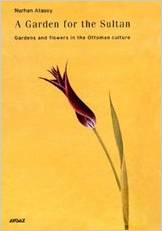
A Garden for the Sultan: Gardens and Flowers in the Ottoman Culture
Caroline Stone
Nurhan Atasoy
Gül Irepoglu, ed.; Mary Isin, English ed.; Robert Bragner and Angela Roome, tr. 2011, Kitap Yayinevi, 978-9-75771-010-3, £60/$90 hb.
A Garden for a Sultan, first published in Turkish in 2002, is a treat on several levels. Not surprisingly, given previous works by Nurhan Atasoy, it is beautifully produced and filled with wonderful and novel illustrations from Topkapı Palace in Istanbul and other collections in Turkey. They include textiles and ceramics, besides numerous paintings and drawings of flowers and gardens and ceremonies involving both. The book considers the classic Islamic idea of the garden and then discusses how it was developed in the context of the Ottoman court. Its social importance is considered, along with the significance of the flowers themselves, which were selectively bred from the 16th century, triggering a similar interest when they were imported to Europe. Descriptions from contemporary sources and from the numerous handbooks on favorite Ottoman flowers—tulips, hyacinths, narcissi, carnations and roses—are particularly valuable. The book will appeal to art lovers and social historians, as well as those interested in flowers, garden design and plant transmission.
You may also be interested in...

Drawing New Conclusions About the Status of Women in Ancient Egypt
Egyptologist Mariam F. Ayad that gender bias among historians accounts for an underrepresentation of women’s lives in historical studies of Egypt.
Children’s Book Documents Rise of Umm Kulthum, Egypt’s Star of the East, As Declaration of National Identity
Illustrator Rhonda Roumani presents an illustrative biography of legendary Egyptian singer and cultural icon Umm Kulthum.
Work Reveals Common Ground Across Massive Desert
The Sahara wasn’t always a desert. Around 9000 BCE it was a bucolic expanse where animals and lush vegetation thrived.